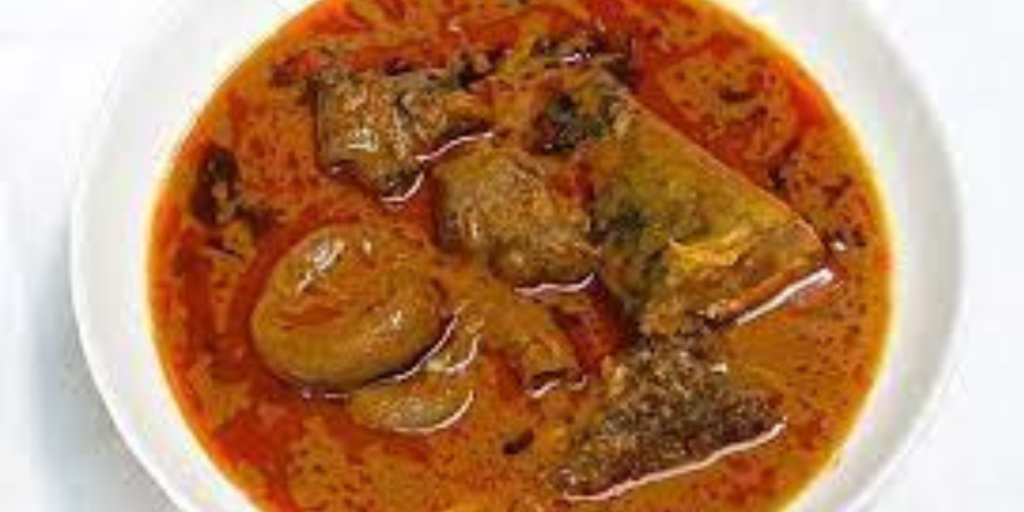Table of Contents
Banga soup, a cherished Nigerian delicacy, captures the essence of rich, aromatic flavors melded with the freshness of fish. This beloved dish, also known as Ofe Akwu, finds its roots in the southern regions of Nigeria, where palm nut oil is abundant and fresh fish is a staple. If you’re ready to embark on a culinary journey filled with bold tastes and tender fish, here is a guide on how to prepare Banga soup using fresh fish as the star ingredient.
1. Gather Your Ingredients

To begin this culinary adventure, assemble the following ingredients:
- 1 large fresh fish (such as tilapia or catfish), cleaned and cut into steaks
- 2 cups of palm nut pulp or canned palm nut concentrate
- 1 medium onion, finely chopped
- 2-3 garlic cloves, minced
- 1-inch piece of ginger, grated
- 2-3 scotch bonnet peppers (adjust to your spice preference)
- 1/2 cup of crayfish, ground
- 1/2 cup of periwinkle (optional)
- 2-3 cups of fish stock or water
- Salt and seasoning cubes to taste
- Fresh green vegetables (ugu leaves or spinach), chopped
2. Prepare the Fresh Fish
Begin by seasoning the fish steaks with salt and a bit of chopped onion. Allow the fish to marinate while you prepare the other ingredients. This step infuses the fish with flavor and ensures a delicious taste in every bite.
3. Blend the Aromatic Base
In a blender, combine the palm nut pulp or concentrate with the chopped onion, garlic, ginger, and scotch bonnet peppers. Blend until smooth, creating a vibrant orange-red mixture that forms the base of the Banga soup.
How to fry a chicken 3 steps In 2024? Best Recipe
4. Cook the Banga Soup Base
Heat a large pot or saucepan over medium heat and add a bit of palm oil. Pour in the blended mixture and let it cook, stirring occasionally, until the palm oil begins to separate from the mixture. This process releases the flavors and creates a fragrant base for the soup.
5. Add the Fish and Stock
Once the soup base has thickened slightly and the palm oil has separated, gently add the seasoned fish steaks to the pot. Pour in the fish stock or water, ensuring that the fish is submerged in the liquid. Allow the soup to simmer gently, allowing the fish to cook through and infuse the broth with its delicate flavors.
What Is The Secret To Good Fried Chicken in 2024
6. Incorporate the Flavors
As the soup simmers, add the ground crayfish and periwinkle (if using) to enhance the seafood essence. Season the soup with salt and seasoning cubes to taste, adjusting the flavors as needed. Let the soup simmer for an additional 10-15 minutes to allow all the flavors to meld together beautifully.
7. Add the Fresh Greens
Finally, add the chopped green vegetables to the pot, stirring them into the simmering soup. The vibrant colors of the greens add a visual appeal while providing a fresh contrast to the rich flavors of the Banga soup. Allow the soup to simmer for a few more minutes until the greens are tender yet vibrant.
Why Nigerian Jollof Is The Best In 2024
8. Serve and Enjoy!
Your Banga soup with fresh fish is now ready to be enjoyed! Ladle generous portions into bowls, making sure to include a fish steak in each serving. Pair the soup with your favorite Nigerian starches such as garri, fufu, or pounded yam for a complete and satisfying meal.

With its tantalizing blend of palm nut goodness and succulent fresh fish, Banga soup is a true celebration of Nigerian cuisine. By following these steps, you can create a pot of flavorful soup that will delight your taste buds and transport you to the heart of West Africa. Whether enjoyed with family or shared among friends, this dish promises a culinary experience that is as rich in tradition as it is in taste. So, gather your ingredients, fire up the stove, and embark on a culinary journey that celebrates the vibrant flavors of Nigerian cuisine with every spoonful.
As our culinary journey through the intricate process of crafting Banga Soup with Fresh Fish in 2024 draws to a close, we find ourselves not only enriched with a sumptuous recipe but also imbued with a deeper understanding of the cultural significance and culinary artistry that surrounds this iconic West African dish.
In delving into the meticulous steps of preparing Banga Soup with Fresh Fish, we have uncovered the delicate balance of flavors and textures that characterizes this beloved dish. From the earthy richness of palm fruit extract to the savory sweetness of fresh fish, each ingredient plays a crucial role in creating a symphony of tastes that dance harmoniously on the palate.
But beyond its culinary appeal, Banga Soup serves as a cultural touchstone, a symbol of heritage and tradition passed down through generations. Its preparation is not merely a matter of mixing ingredients but a ritual of connection, community, and shared experience. From the rhythmic pounding of spices to the joyful laughter shared around the cooking pot, every moment in the kitchen becomes a celebration of culture and identity.
Moreover, the use of fresh fish in Banga Soup speaks to a commitment to quality and sustainability in modern culinary practices. By sourcing locally caught fish and seasonal ingredients, chefs and home cooks alike honor the natural bounty of the land and sea, infusing their dishes with a sense of place and stewardship for the environment.
As we bid farewell to our exploration of Banga Soup with Fresh Fish in 2024, let us carry forward the lessons learned and the memories made. Let us continue to embrace the richness and diversity of West African cuisine, celebrating its flavors and traditions with every delicious bite. And above all, let us savor each moment spent in the kitchen, where the simple act of cooking becomes a celebration of culture, community, and connection.





















